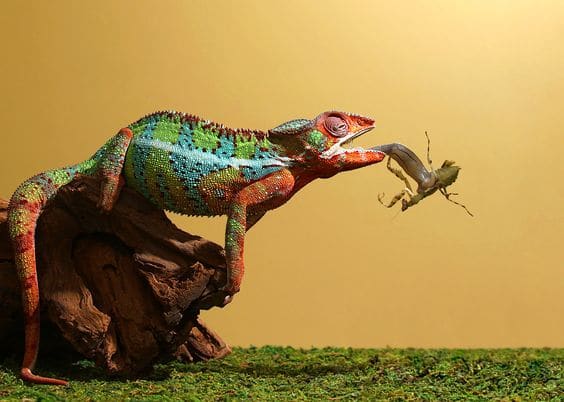If you want a classy pet that changes color every time you look at it, a chameleon is a perfect option for you!
It is great for keeping a pet at home as long as you meet all of their nutritional needs. Chameleons are fascinating pets and are said to be pleasant reptiles.
Planning your chameleon’s diet with care will let them live the finest, fullest life possible. While buying food for your Chameleon, there are a few points to bear in mind so we will suggest reading the complete guide before proceeding.
Fortunately, these lists are pretty simple. You’ll also be glad to learn that maintaining a chameleon’s diet is really inexpensive.
Let’s get started!
Chameleon Diet Introduction:
Chameleons eat almost everything. They utilize both meat and vegetables to gain the nutrition they require for sustenance.
Young chameleons consume more food than mature chameleons, so they must always have access to healthy food. To ensure that they are healthy, the proper quantity of food must be provided.
Almost all chameleons enjoy eating insects, however, some may prefer greens instead. Therefore, to keep them alive and healthy, feed them the greatest nutrient-dense food items. Continue reading to learn further about your chameleon’s diet.
Insects, They adore Them!
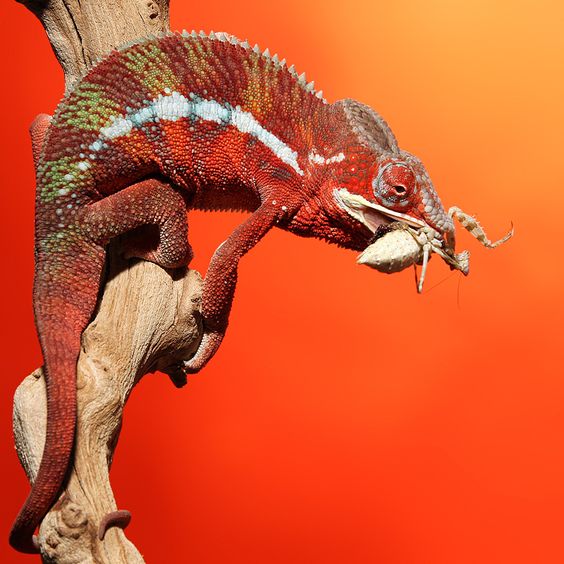
When it comes to food, your chameleon prefers insects. To supply the necessary nutrient value, you must feed them the appropriate sorts. Dubia Roaches, Hornworms, Crickets, and Reptiworms are the most common insects. Feed them Mealworms, Superworms, and Waxworms on a regular basis to supply the necessary amount of fat.
Be cautious of the nutrient properties of the creatures you feed your chameleon—not all creepy insects are made equal and not all have the same nutrition value that is adequate for your chameleon health.
Gut Loading Chameleon Food:
Enabling the insects you plan to feed your chameleon to consume a range of healthy food for up to 24 hours prior to feeding time is referred to as gut loading. Typically, let the bugs feast the night before.
You must consider the insects you serve your chameleon as empty vessels into which nourishing food is placed. When your chameleon eats it, the nutrition in the insect’s intestines will be transferred to them.
Green beans, leafy green vegetables, mustard greens, dandelion leaves, papaya, and arugula are amongst the greatest materials for gut-loading insects. When you give these nutritious greens to your insects, the nutrients are passed on to your chameleon, who eats the insects.
Dust off the insect that you give your chameleon so that it is completely healthy for it.
Dietary supplementation of your chameleon’s food with specific vitamins is very necessary for keeping a healthy chameleon.
Greens & Veggies:
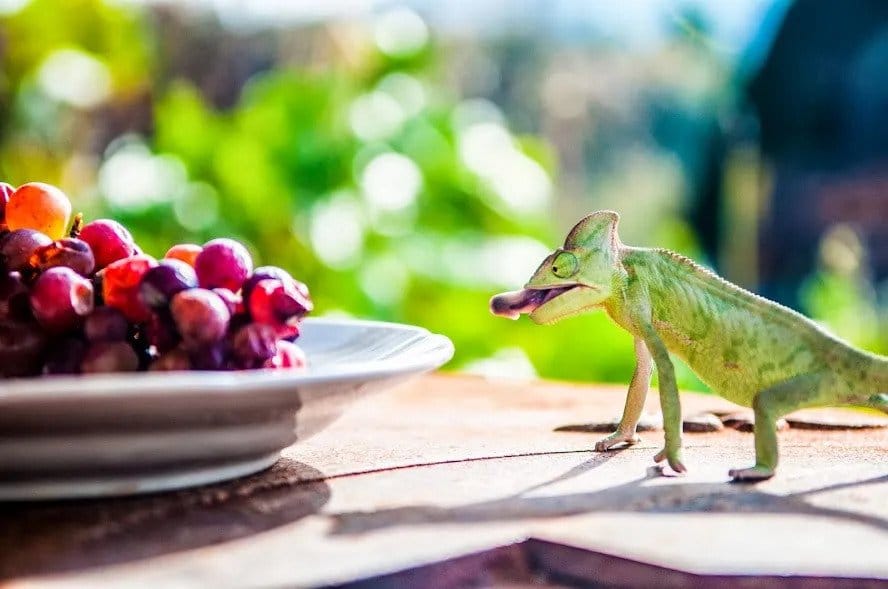
Some chameleons may like chewing on greens all day, while others may dislike them so intensely that they would never eat them.
This is why it is always a smart option to provide the bug with as many greens as possible to guarantee they are acquiring the nutrients they need to pass on to your pet.
If your chameleon eats plants, leafy greens are an excellent choice. Here is a handful list that you can serve on a regular basis:
- Collard Greens
- Greens Mustard
- Endive
- Escarole
Supplements for the Diet:
Supplements are useful for more than just preserving the benefits! A dietary supplement is a crucial aspect of providing your chameleon with a well-balanced diet.
You must supplement your chameleon’s food with calcium, phosphorus, and vitamins A and D to ensure that it does not get hungry.
The supplements are available in a specifically prepared combination or separately; both will offer the intended outcome. When serving your pet insects or vegetables, gently coat it with Reptivite.
However, considering the fact that Reptivite contains Vitamin D3, thus this should only be done on rare occasions. Calcium deficient in D3 ought to be the bread and butter of your dusting regimen.
Would it be Fine to Feed Mice to Chameleons?
Many online publications recommend feeding you chameleon mice.
While it is conceivable, we strongly advise against it.
Chameleons of sufficient size may consume mice. Mice, on the other hand, should be avoided in your chameleon’s diet owing to their high-fat content.
Many pet owners opt to eliminate mice from their chameleons’ diets entirely since, while they may provide some nutritional benefit, the fat level is just too excessive.
If you still want to feed your chameleon mice, ensure they are newborns. Feed them to your chameleon in moderation.
Chameleons Eat Dead Insects or Not?
Food that has been freeze-dried is difficult for chameleons to recognize. When chameleons are in their native habitat, they have a better chance of detecting food since they can detect live and moving insects.
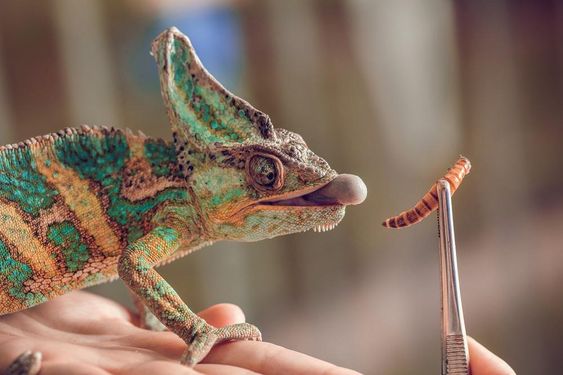
However, a chameleon in captivity may struggle to distinguish food. Keeping a little mini-ecosystem and keeping living earthworms and bugs within the house can be time-consuming.
Freeze-dried food is useful in this situation since it may be obtained from a nearby pet store or retrieved from the natural environment. So, depending on what’s available, you can give them live crickets.
Individual pets’ preferences for frozen crickets vary, as some enjoy eating dead insects while others do not. As a result, it is preferable to feed them live crickets.
Providing Adequate Hydration
A chameleon is unlikely to be found sipping from a water bowl. They like relying on plants for hydration. They swallow the droplets that fall from the plant’s base.
Spray the plants in the cage with water to fulfill your chameleon’s needs and supply the necessary hydration. You may need to perform it four to five times each day.
A basic spray bottle or a pressurized spray bottle can be used. Chameleons can drink tap water.
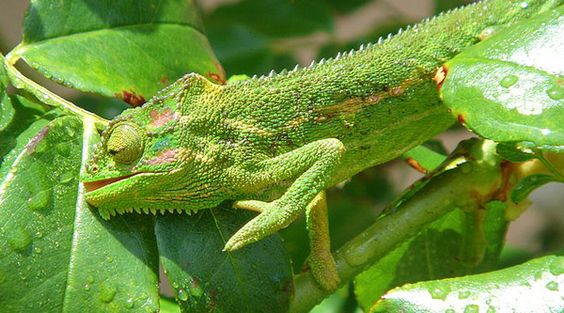
Just ensure that the water doesn’t have a lot of chlorine or chemicals in it. Including greens in your chameleon’s food on a daily basis is another approach to supply more water.
However, spray it on a frequent basis to keep it moisturized.
Foods that you must avoid giving your Chameleon
*NEVER FEED YOUR CHAMELEON EVERYTHING YOU FIND AROUND THE HOUSE*.
Bugs captured in the wild have a significant risk of transferring diseases to your chameleon.
Here is a short list of foods that you should eliminate from your chameleon’s diet:
- Fireflies: Extremely toxic to chameleons
- Kale: Can cause stomach issues in your chameleon.
- Spinach: Calcium absorption is inhibited.
- Mango: Toxic to chameleons
- Broccoli: Can wreak havoc on nutritional levels
Fruits are a delicious treat for pet chameleons, but acid fruits should be strictly avoided. Furthermore, keep a close eye on how various insects affect your chameleon’s bowel motions.
How Much Food Should a Chameleon Consume?
The amount of food a chameleon consumes is determined by its life stage.
Baby chameleons are like garbage cans! They devour a lot of food for such a small creature. Youngsters have to be fed as often as they can consume, twice a day till they are 6 months old, which is generally up to 15 tiny insects.
At between ages of 6 and 12 months, their hunger decreases slightly, and they are served once per day up to 10 medium-sized insects.
Following this, their eating patterns are irregular, but providing them with up to 6 full-sized insects over 2 or 3 days ensures that they eat fairly reliably.
What is the Purpose of a Chameleon Eating Dirt?
A chameleon eating dirt is not harmful in and of itself, but we must investigate whether there are infections or chemical fertilizers present. In case there is such a presence then there’s the danger of illness and death of the chameleon. However, this conduct should not be discouraged.
Rather, the goal should be to figure out what is causing this behavior.
If a chameleon’s diet lacks some necessary elements, it may turn to eat dirt. This might be seen as a hint that it is time to make some dietary modifications to offer all of the needed nutrients.
You may also see a veterinarian to learn about the nutrition that must be added to the diet.
But first and foremost, you must stop the chameleon from eating soil, which may be accomplished by covering the area with a lid or some stones and plants.
Why isn’t Your Chameleon Eating?
The significant cause a chameleon quits eating is when it is given the same bug too frequently.
This is why I emphasize the need of changing both staples and special foods occasionally.
Other reasons your chameleon isn’t eating might include a parasite illness, improper heating and temperature control, or if your chameleon is female and preparing to produce eggs.
Conclusion:
Feeding a chameleon does not have to be complicated. The most important fact to notice is that insects must be gut-loaded and nourished. Ensure they must be in excellent condition in order to maintain your chameleon in excellent condition.
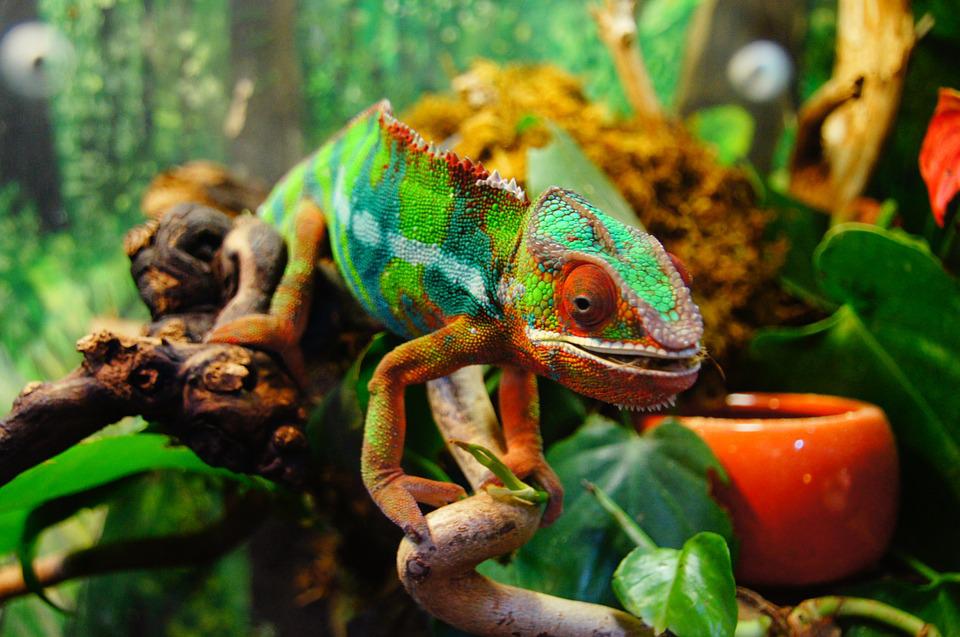
Remember that each chameleon is unique, thus their dietary patterns may change.
Keep a close eye on them and provide them with their favorite healthful and diverse foods.
Follow the diet to keep your chameleon happier and healthier!
FAQ’s
The most evident red signal is a prolonged lack of bowel motions despite normal feedings. This may be followed by the chameleon obviously struggling to defecate, a bloated belly, and, ultimately, refusal to eat.
If you suspect your pet’s intestines are impacted, seek veterinarian care.
Some of the greatest methods to tell if a chameleon is healthy are behavioral patterns. Your chameleon should be energetic, and its body should be appropriately “full out” to its length.
Chameleons that are starved become sluggish and discharge mucus from their lips and nostrils. They will begin to waste as a result of low nutrition intake.
Too much D3 can accumulate and induce bone uptake and tissue mineralization. For bone growth, the amounts of D3, calcium, and vitamin A must be balanced.
Adult veiled chameleons can be fed once a day, once a week, or as required to ensure their ideal weight. Baby and immature veiled chameleons should be fed 1-2 times per day as many times as they would like.
Whereas adults can be fed once a day, every so often, or as required to maintain their target weight.
To supply additional nutrition, you should enrich your veiled chameleon’s meals with calcium and vitamin dustings.
If they continue to reject what you feed them, miss a meal or two until their appetite returns. A healthy chameleon may survive for up to a week without eating. In times of adversity, they may go longer without food, but a week without food is generally enough to return them to a condition where they eat since they are hungry.
About The Author


